Forming a Smoking Cessation Program for Indigenous Blacktown Suburb Residents
VerifiedAdded on 2023/06/11
|13
|3551
|350
AI Summary
This program aims to reduce high rates of smoking among indigenous people in Blacktown suburbs, enhancing their overall health and wellbeing. The program will focus on smoking cessation, community interventions, and psychosocial support.
Contribute Materials
Your contribution can guide someone’s learning journey. Share your
documents today.
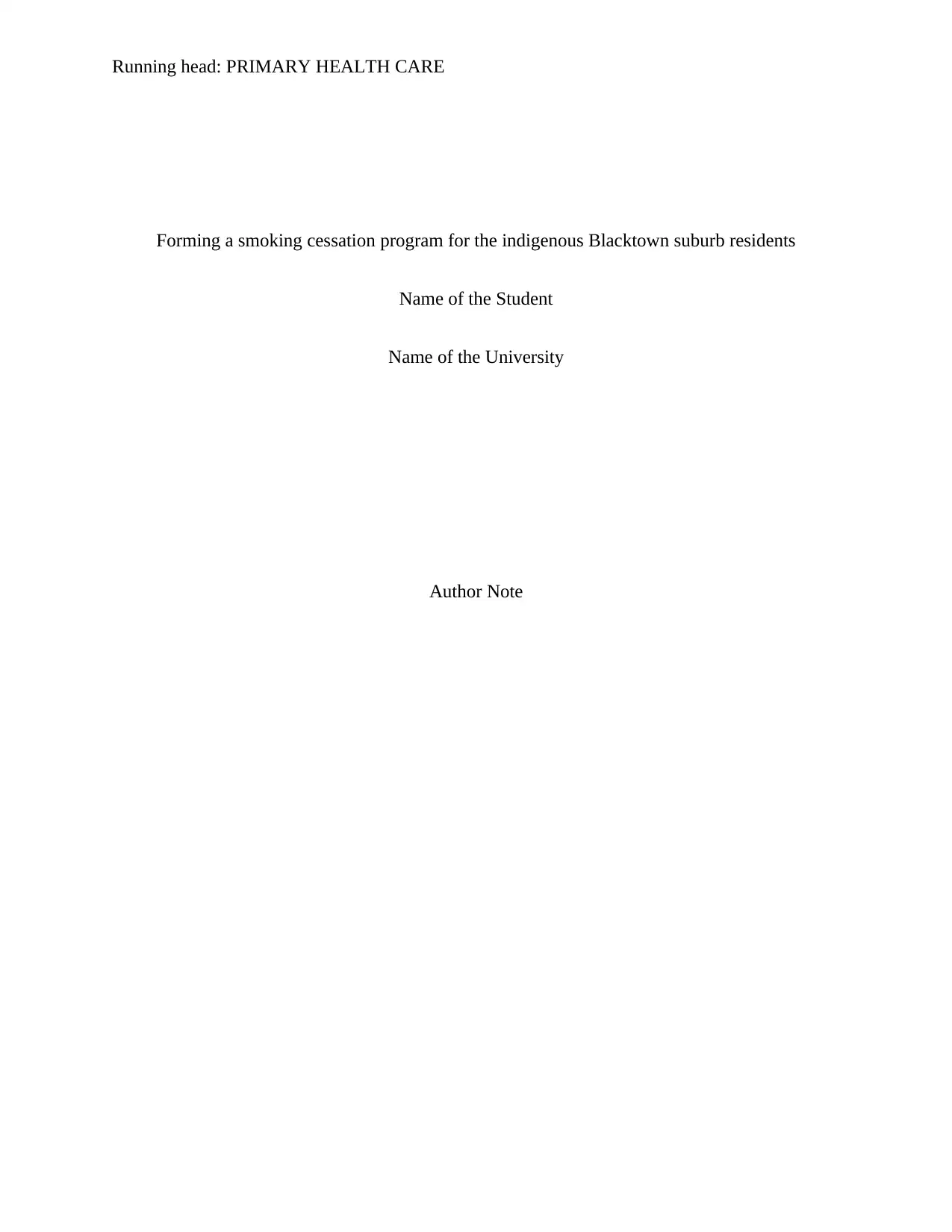
Running head: PRIMARY HEALTH CARE
Forming a smoking cessation program for the indigenous Blacktown suburb residents
Name of the Student
Name of the University
Author Note
Forming a smoking cessation program for the indigenous Blacktown suburb residents
Name of the Student
Name of the University
Author Note
Secure Best Marks with AI Grader
Need help grading? Try our AI Grader for instant feedback on your assignments.
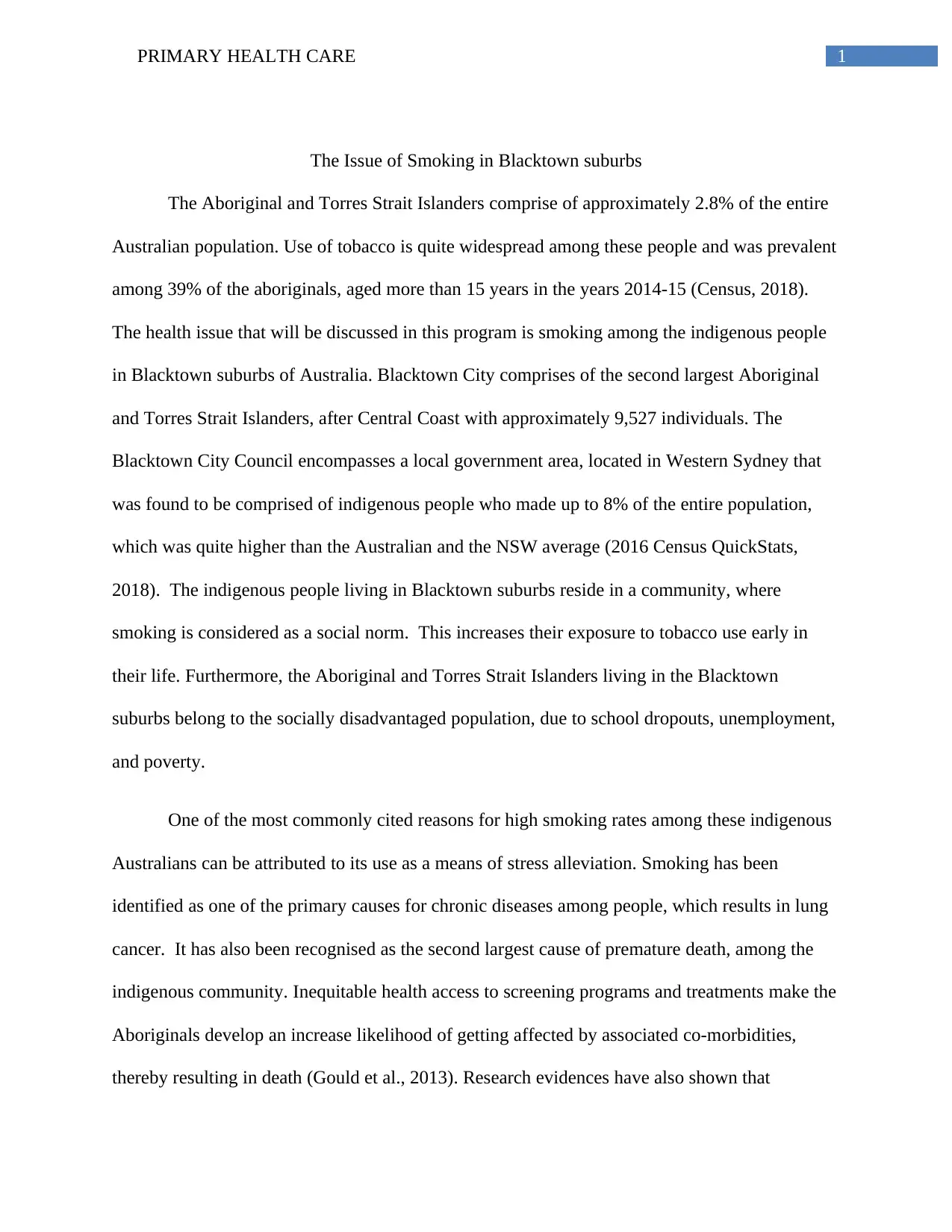
1PRIMARY HEALTH CARE
The Issue of Smoking in Blacktown suburbs
The Aboriginal and Torres Strait Islanders comprise of approximately 2.8% of the entire
Australian population. Use of tobacco is quite widespread among these people and was prevalent
among 39% of the aboriginals, aged more than 15 years in the years 2014-15 (Census, 2018).
The health issue that will be discussed in this program is smoking among the indigenous people
in Blacktown suburbs of Australia. Blacktown City comprises of the second largest Aboriginal
and Torres Strait Islanders, after Central Coast with approximately 9,527 individuals. The
Blacktown City Council encompasses a local government area, located in Western Sydney that
was found to be comprised of indigenous people who made up to 8% of the entire population,
which was quite higher than the Australian and the NSW average (2016 Census QuickStats,
2018). The indigenous people living in Blacktown suburbs reside in a community, where
smoking is considered as a social norm. This increases their exposure to tobacco use early in
their life. Furthermore, the Aboriginal and Torres Strait Islanders living in the Blacktown
suburbs belong to the socially disadvantaged population, due to school dropouts, unemployment,
and poverty.
One of the most commonly cited reasons for high smoking rates among these indigenous
Australians can be attributed to its use as a means of stress alleviation. Smoking has been
identified as one of the primary causes for chronic diseases among people, which results in lung
cancer. It has also been recognised as the second largest cause of premature death, among the
indigenous community. Inequitable health access to screening programs and treatments make the
Aboriginals develop an increase likelihood of getting affected by associated co-morbidities,
thereby resulting in death (Gould et al., 2013). Research evidences have also shown that
The Issue of Smoking in Blacktown suburbs
The Aboriginal and Torres Strait Islanders comprise of approximately 2.8% of the entire
Australian population. Use of tobacco is quite widespread among these people and was prevalent
among 39% of the aboriginals, aged more than 15 years in the years 2014-15 (Census, 2018).
The health issue that will be discussed in this program is smoking among the indigenous people
in Blacktown suburbs of Australia. Blacktown City comprises of the second largest Aboriginal
and Torres Strait Islanders, after Central Coast with approximately 9,527 individuals. The
Blacktown City Council encompasses a local government area, located in Western Sydney that
was found to be comprised of indigenous people who made up to 8% of the entire population,
which was quite higher than the Australian and the NSW average (2016 Census QuickStats,
2018). The indigenous people living in Blacktown suburbs reside in a community, where
smoking is considered as a social norm. This increases their exposure to tobacco use early in
their life. Furthermore, the Aboriginal and Torres Strait Islanders living in the Blacktown
suburbs belong to the socially disadvantaged population, due to school dropouts, unemployment,
and poverty.
One of the most commonly cited reasons for high smoking rates among these indigenous
Australians can be attributed to its use as a means of stress alleviation. Smoking has been
identified as one of the primary causes for chronic diseases among people, which results in lung
cancer. It has also been recognised as the second largest cause of premature death, among the
indigenous community. Inequitable health access to screening programs and treatments make the
Aboriginals develop an increase likelihood of getting affected by associated co-morbidities,
thereby resulting in death (Gould et al., 2013). Research evidences have also shown that
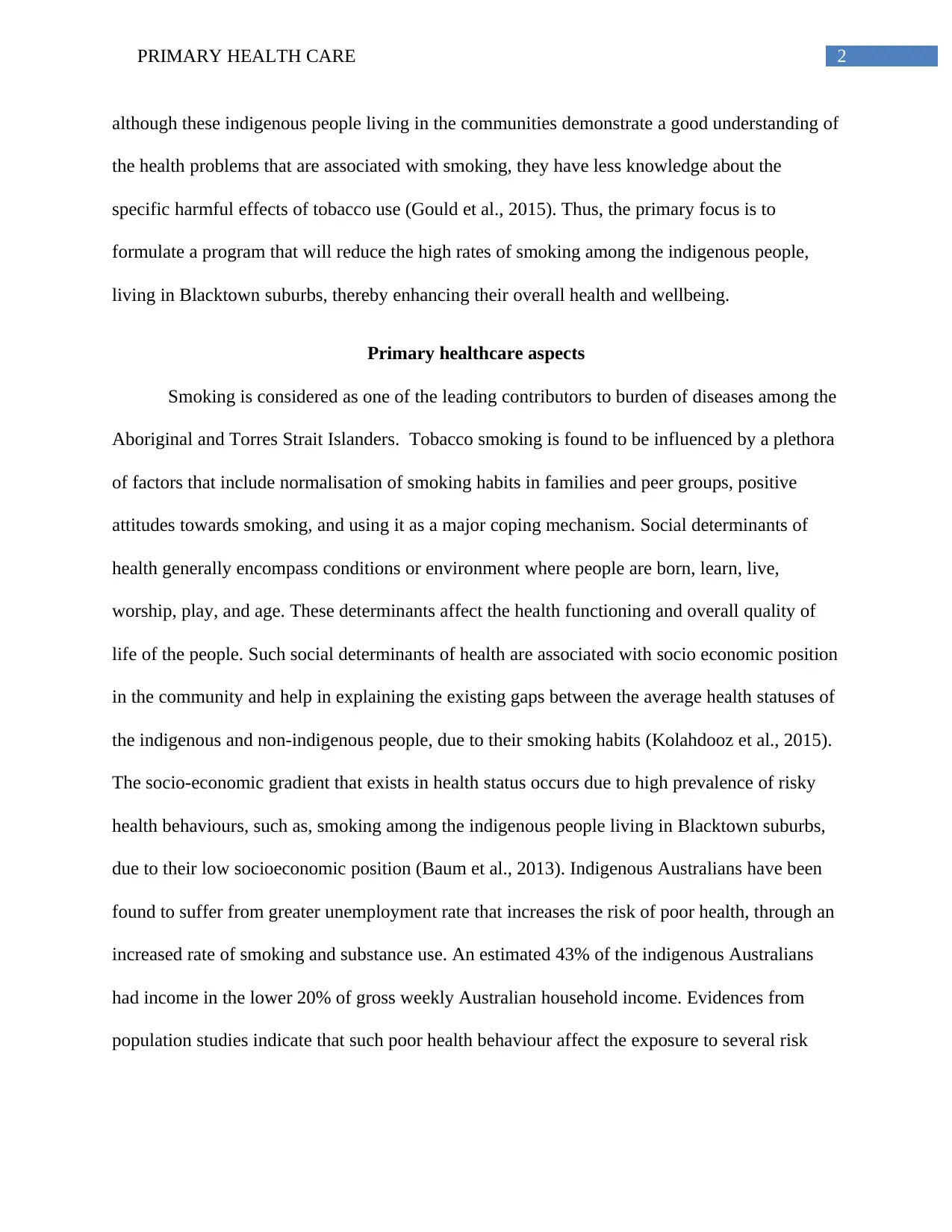
2PRIMARY HEALTH CARE
although these indigenous people living in the communities demonstrate a good understanding of
the health problems that are associated with smoking, they have less knowledge about the
specific harmful effects of tobacco use (Gould et al., 2015). Thus, the primary focus is to
formulate a program that will reduce the high rates of smoking among the indigenous people,
living in Blacktown suburbs, thereby enhancing their overall health and wellbeing.
Primary healthcare aspects
Smoking is considered as one of the leading contributors to burden of diseases among the
Aboriginal and Torres Strait Islanders. Tobacco smoking is found to be influenced by a plethora
of factors that include normalisation of smoking habits in families and peer groups, positive
attitudes towards smoking, and using it as a major coping mechanism. Social determinants of
health generally encompass conditions or environment where people are born, learn, live,
worship, play, and age. These determinants affect the health functioning and overall quality of
life of the people. Such social determinants of health are associated with socio economic position
in the community and help in explaining the existing gaps between the average health statuses of
the indigenous and non-indigenous people, due to their smoking habits (Kolahdooz et al., 2015).
The socio-economic gradient that exists in health status occurs due to high prevalence of risky
health behaviours, such as, smoking among the indigenous people living in Blacktown suburbs,
due to their low socioeconomic position (Baum et al., 2013). Indigenous Australians have been
found to suffer from greater unemployment rate that increases the risk of poor health, through an
increased rate of smoking and substance use. An estimated 43% of the indigenous Australians
had income in the lower 20% of gross weekly Australian household income. Evidences from
population studies indicate that such poor health behaviour affect the exposure to several risk
although these indigenous people living in the communities demonstrate a good understanding of
the health problems that are associated with smoking, they have less knowledge about the
specific harmful effects of tobacco use (Gould et al., 2015). Thus, the primary focus is to
formulate a program that will reduce the high rates of smoking among the indigenous people,
living in Blacktown suburbs, thereby enhancing their overall health and wellbeing.
Primary healthcare aspects
Smoking is considered as one of the leading contributors to burden of diseases among the
Aboriginal and Torres Strait Islanders. Tobacco smoking is found to be influenced by a plethora
of factors that include normalisation of smoking habits in families and peer groups, positive
attitudes towards smoking, and using it as a major coping mechanism. Social determinants of
health generally encompass conditions or environment where people are born, learn, live,
worship, play, and age. These determinants affect the health functioning and overall quality of
life of the people. Such social determinants of health are associated with socio economic position
in the community and help in explaining the existing gaps between the average health statuses of
the indigenous and non-indigenous people, due to their smoking habits (Kolahdooz et al., 2015).
The socio-economic gradient that exists in health status occurs due to high prevalence of risky
health behaviours, such as, smoking among the indigenous people living in Blacktown suburbs,
due to their low socioeconomic position (Baum et al., 2013). Indigenous Australians have been
found to suffer from greater unemployment rate that increases the risk of poor health, through an
increased rate of smoking and substance use. An estimated 43% of the indigenous Australians
had income in the lower 20% of gross weekly Australian household income. Evidences from
population studies indicate that such poor health behaviour affect the exposure to several risk
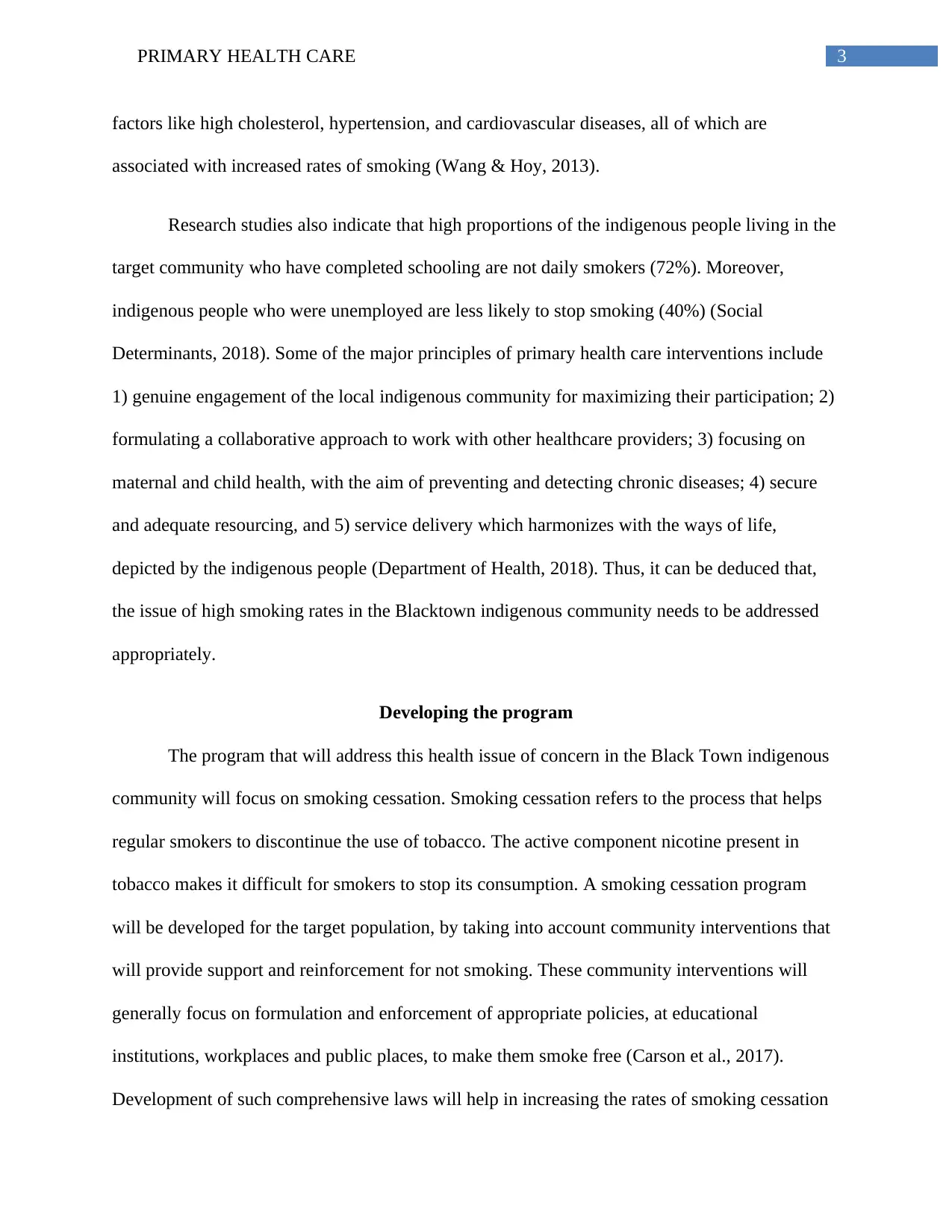
3PRIMARY HEALTH CARE
factors like high cholesterol, hypertension, and cardiovascular diseases, all of which are
associated with increased rates of smoking (Wang & Hoy, 2013).
Research studies also indicate that high proportions of the indigenous people living in the
target community who have completed schooling are not daily smokers (72%). Moreover,
indigenous people who were unemployed are less likely to stop smoking (40%) (Social
Determinants, 2018). Some of the major principles of primary health care interventions include
1) genuine engagement of the local indigenous community for maximizing their participation; 2)
formulating a collaborative approach to work with other healthcare providers; 3) focusing on
maternal and child health, with the aim of preventing and detecting chronic diseases; 4) secure
and adequate resourcing, and 5) service delivery which harmonizes with the ways of life,
depicted by the indigenous people (Department of Health, 2018). Thus, it can be deduced that,
the issue of high smoking rates in the Blacktown indigenous community needs to be addressed
appropriately.
Developing the program
The program that will address this health issue of concern in the Black Town indigenous
community will focus on smoking cessation. Smoking cessation refers to the process that helps
regular smokers to discontinue the use of tobacco. The active component nicotine present in
tobacco makes it difficult for smokers to stop its consumption. A smoking cessation program
will be developed for the target population, by taking into account community interventions that
will provide support and reinforcement for not smoking. These community interventions will
generally focus on formulation and enforcement of appropriate policies, at educational
institutions, workplaces and public places, to make them smoke free (Carson et al., 2017).
Development of such comprehensive laws will help in increasing the rates of smoking cessation
factors like high cholesterol, hypertension, and cardiovascular diseases, all of which are
associated with increased rates of smoking (Wang & Hoy, 2013).
Research studies also indicate that high proportions of the indigenous people living in the
target community who have completed schooling are not daily smokers (72%). Moreover,
indigenous people who were unemployed are less likely to stop smoking (40%) (Social
Determinants, 2018). Some of the major principles of primary health care interventions include
1) genuine engagement of the local indigenous community for maximizing their participation; 2)
formulating a collaborative approach to work with other healthcare providers; 3) focusing on
maternal and child health, with the aim of preventing and detecting chronic diseases; 4) secure
and adequate resourcing, and 5) service delivery which harmonizes with the ways of life,
depicted by the indigenous people (Department of Health, 2018). Thus, it can be deduced that,
the issue of high smoking rates in the Blacktown indigenous community needs to be addressed
appropriately.
Developing the program
The program that will address this health issue of concern in the Black Town indigenous
community will focus on smoking cessation. Smoking cessation refers to the process that helps
regular smokers to discontinue the use of tobacco. The active component nicotine present in
tobacco makes it difficult for smokers to stop its consumption. A smoking cessation program
will be developed for the target population, by taking into account community interventions that
will provide support and reinforcement for not smoking. These community interventions will
generally focus on formulation and enforcement of appropriate policies, at educational
institutions, workplaces and public places, to make them smoke free (Carson et al., 2017).
Development of such comprehensive laws will help in increasing the rates of smoking cessation
Secure Best Marks with AI Grader
Need help grading? Try our AI Grader for instant feedback on your assignments.
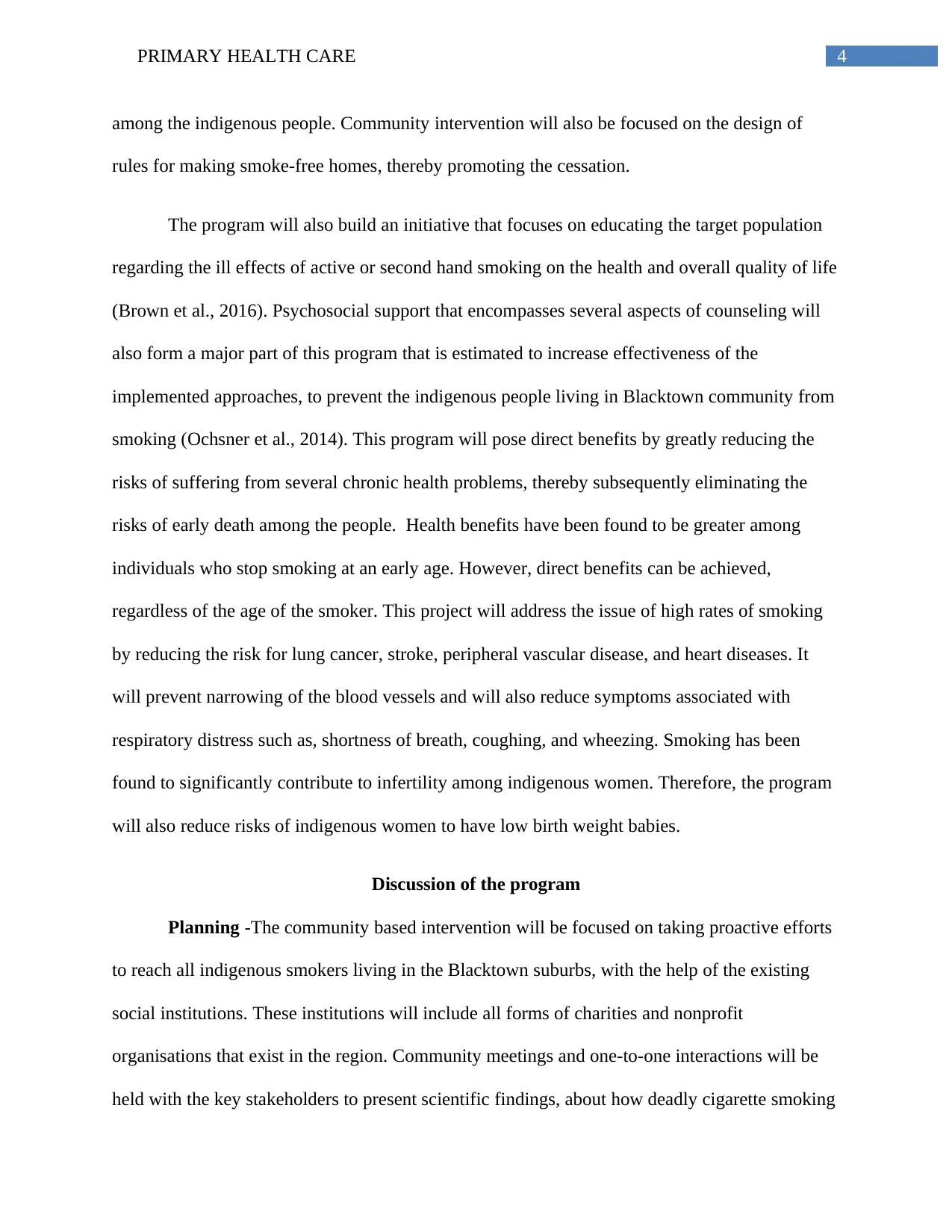
4PRIMARY HEALTH CARE
among the indigenous people. Community intervention will also be focused on the design of
rules for making smoke-free homes, thereby promoting the cessation.
The program will also build an initiative that focuses on educating the target population
regarding the ill effects of active or second hand smoking on the health and overall quality of life
(Brown et al., 2016). Psychosocial support that encompasses several aspects of counseling will
also form a major part of this program that is estimated to increase effectiveness of the
implemented approaches, to prevent the indigenous people living in Blacktown community from
smoking (Ochsner et al., 2014). This program will pose direct benefits by greatly reducing the
risks of suffering from several chronic health problems, thereby subsequently eliminating the
risks of early death among the people. Health benefits have been found to be greater among
individuals who stop smoking at an early age. However, direct benefits can be achieved,
regardless of the age of the smoker. This project will address the issue of high rates of smoking
by reducing the risk for lung cancer, stroke, peripheral vascular disease, and heart diseases. It
will prevent narrowing of the blood vessels and will also reduce symptoms associated with
respiratory distress such as, shortness of breath, coughing, and wheezing. Smoking has been
found to significantly contribute to infertility among indigenous women. Therefore, the program
will also reduce risks of indigenous women to have low birth weight babies.
Discussion of the program
Planning -The community based intervention will be focused on taking proactive efforts
to reach all indigenous smokers living in the Blacktown suburbs, with the help of the existing
social institutions. These institutions will include all forms of charities and nonprofit
organisations that exist in the region. Community meetings and one-to-one interactions will be
held with the key stakeholders to present scientific findings, about how deadly cigarette smoking
among the indigenous people. Community intervention will also be focused on the design of
rules for making smoke-free homes, thereby promoting the cessation.
The program will also build an initiative that focuses on educating the target population
regarding the ill effects of active or second hand smoking on the health and overall quality of life
(Brown et al., 2016). Psychosocial support that encompasses several aspects of counseling will
also form a major part of this program that is estimated to increase effectiveness of the
implemented approaches, to prevent the indigenous people living in Blacktown community from
smoking (Ochsner et al., 2014). This program will pose direct benefits by greatly reducing the
risks of suffering from several chronic health problems, thereby subsequently eliminating the
risks of early death among the people. Health benefits have been found to be greater among
individuals who stop smoking at an early age. However, direct benefits can be achieved,
regardless of the age of the smoker. This project will address the issue of high rates of smoking
by reducing the risk for lung cancer, stroke, peripheral vascular disease, and heart diseases. It
will prevent narrowing of the blood vessels and will also reduce symptoms associated with
respiratory distress such as, shortness of breath, coughing, and wheezing. Smoking has been
found to significantly contribute to infertility among indigenous women. Therefore, the program
will also reduce risks of indigenous women to have low birth weight babies.
Discussion of the program
Planning -The community based intervention will be focused on taking proactive efforts
to reach all indigenous smokers living in the Blacktown suburbs, with the help of the existing
social institutions. These institutions will include all forms of charities and nonprofit
organisations that exist in the region. Community meetings and one-to-one interactions will be
held with the key stakeholders to present scientific findings, about how deadly cigarette smoking
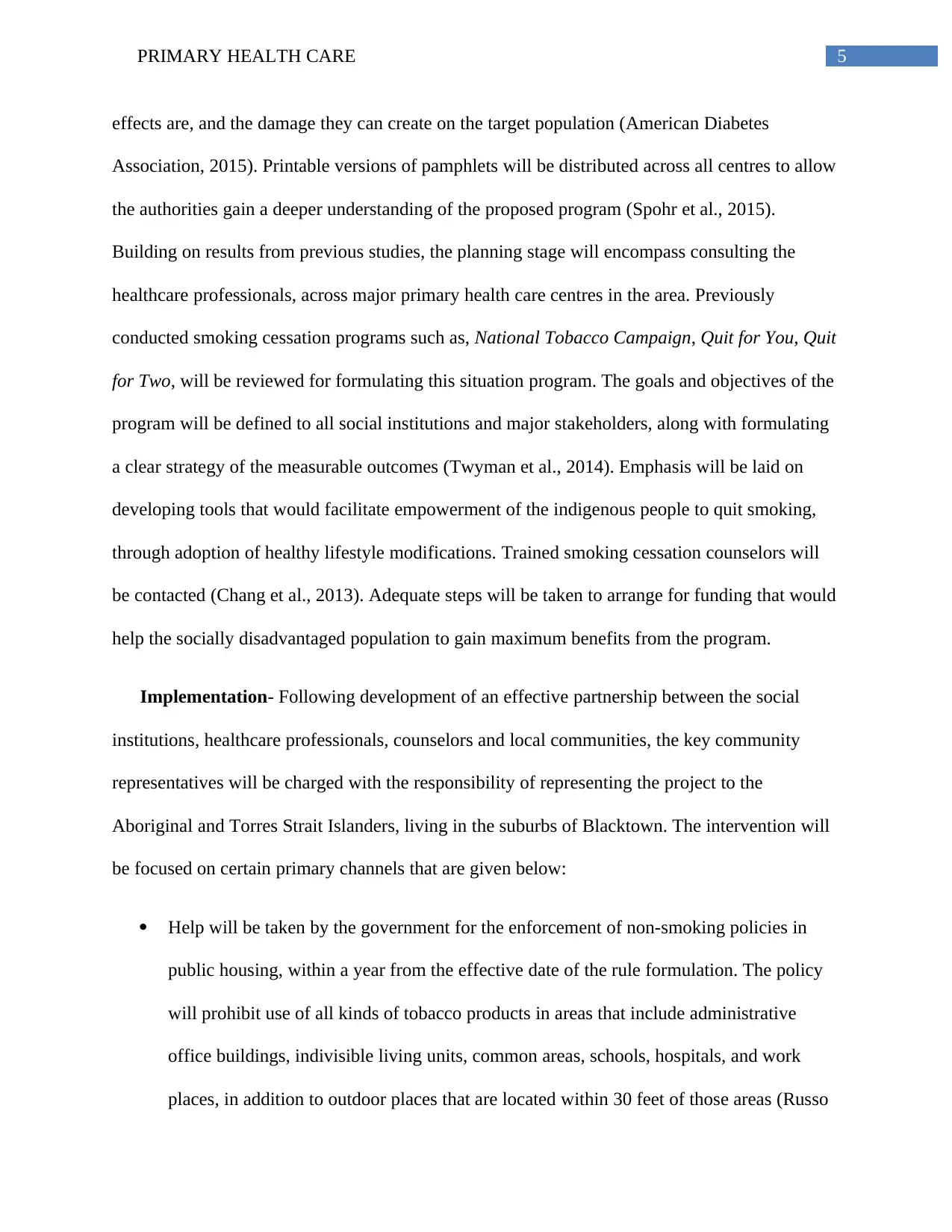
5PRIMARY HEALTH CARE
effects are, and the damage they can create on the target population (American Diabetes
Association, 2015). Printable versions of pamphlets will be distributed across all centres to allow
the authorities gain a deeper understanding of the proposed program (Spohr et al., 2015).
Building on results from previous studies, the planning stage will encompass consulting the
healthcare professionals, across major primary health care centres in the area. Previously
conducted smoking cessation programs such as, National Tobacco Campaign, Quit for You, Quit
for Two, will be reviewed for formulating this situation program. The goals and objectives of the
program will be defined to all social institutions and major stakeholders, along with formulating
a clear strategy of the measurable outcomes (Twyman et al., 2014). Emphasis will be laid on
developing tools that would facilitate empowerment of the indigenous people to quit smoking,
through adoption of healthy lifestyle modifications. Trained smoking cessation counselors will
be contacted (Chang et al., 2013). Adequate steps will be taken to arrange for funding that would
help the socially disadvantaged population to gain maximum benefits from the program.
Implementation- Following development of an effective partnership between the social
institutions, healthcare professionals, counselors and local communities, the key community
representatives will be charged with the responsibility of representing the project to the
Aboriginal and Torres Strait Islanders, living in the suburbs of Blacktown. The intervention will
be focused on certain primary channels that are given below:
Help will be taken by the government for the enforcement of non-smoking policies in
public housing, within a year from the effective date of the rule formulation. The policy
will prohibit use of all kinds of tobacco products in areas that include administrative
office buildings, indivisible living units, common areas, schools, hospitals, and work
places, in addition to outdoor places that are located within 30 feet of those areas (Russo
effects are, and the damage they can create on the target population (American Diabetes
Association, 2015). Printable versions of pamphlets will be distributed across all centres to allow
the authorities gain a deeper understanding of the proposed program (Spohr et al., 2015).
Building on results from previous studies, the planning stage will encompass consulting the
healthcare professionals, across major primary health care centres in the area. Previously
conducted smoking cessation programs such as, National Tobacco Campaign, Quit for You, Quit
for Two, will be reviewed for formulating this situation program. The goals and objectives of the
program will be defined to all social institutions and major stakeholders, along with formulating
a clear strategy of the measurable outcomes (Twyman et al., 2014). Emphasis will be laid on
developing tools that would facilitate empowerment of the indigenous people to quit smoking,
through adoption of healthy lifestyle modifications. Trained smoking cessation counselors will
be contacted (Chang et al., 2013). Adequate steps will be taken to arrange for funding that would
help the socially disadvantaged population to gain maximum benefits from the program.
Implementation- Following development of an effective partnership between the social
institutions, healthcare professionals, counselors and local communities, the key community
representatives will be charged with the responsibility of representing the project to the
Aboriginal and Torres Strait Islanders, living in the suburbs of Blacktown. The intervention will
be focused on certain primary channels that are given below:
Help will be taken by the government for the enforcement of non-smoking policies in
public housing, within a year from the effective date of the rule formulation. The policy
will prohibit use of all kinds of tobacco products in areas that include administrative
office buildings, indivisible living units, common areas, schools, hospitals, and work
places, in addition to outdoor places that are located within 30 feet of those areas (Russo
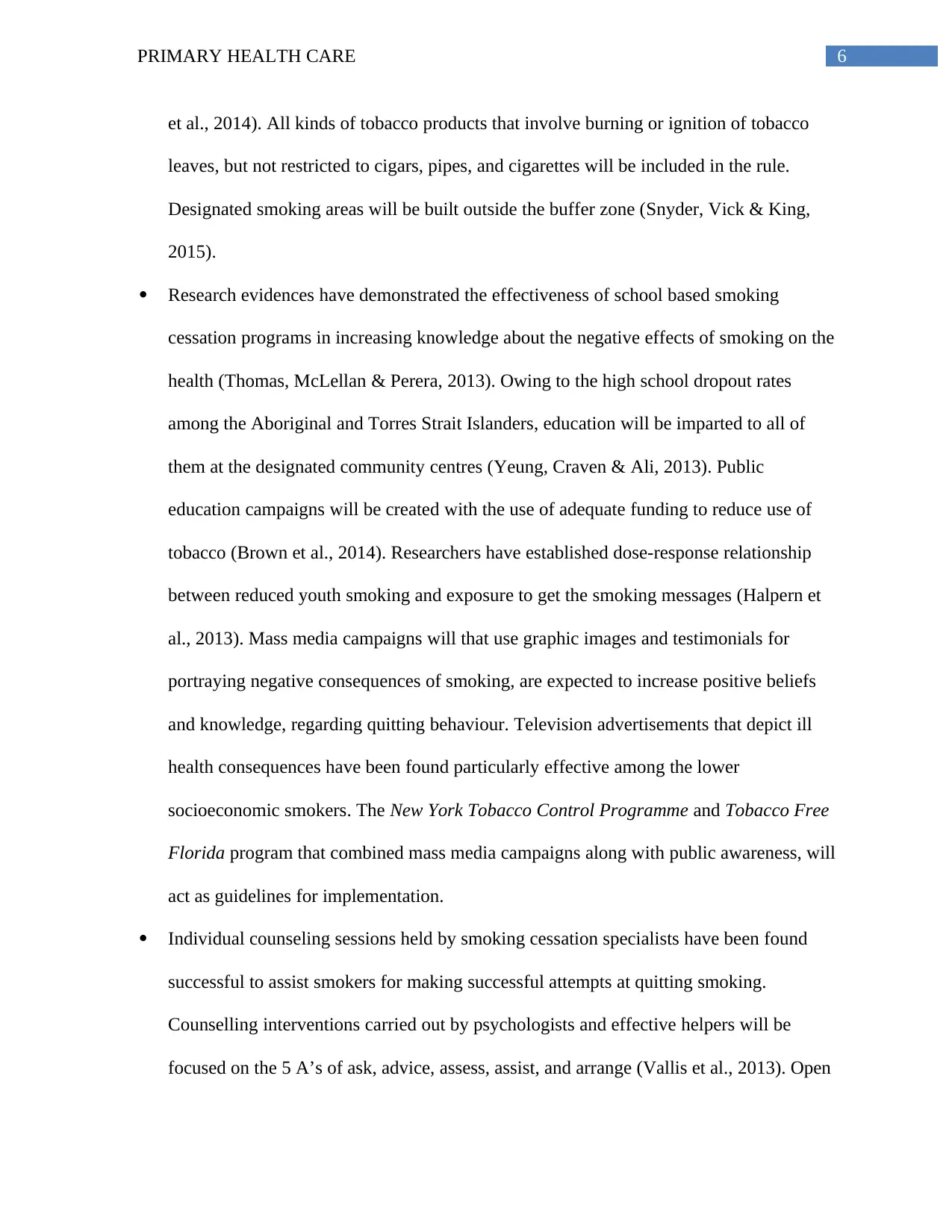
6PRIMARY HEALTH CARE
et al., 2014). All kinds of tobacco products that involve burning or ignition of tobacco
leaves, but not restricted to cigars, pipes, and cigarettes will be included in the rule.
Designated smoking areas will be built outside the buffer zone (Snyder, Vick & King,
2015).
Research evidences have demonstrated the effectiveness of school based smoking
cessation programs in increasing knowledge about the negative effects of smoking on the
health (Thomas, McLellan & Perera, 2013). Owing to the high school dropout rates
among the Aboriginal and Torres Strait Islanders, education will be imparted to all of
them at the designated community centres (Yeung, Craven & Ali, 2013). Public
education campaigns will be created with the use of adequate funding to reduce use of
tobacco (Brown et al., 2014). Researchers have established dose-response relationship
between reduced youth smoking and exposure to get the smoking messages (Halpern et
al., 2013). Mass media campaigns will that use graphic images and testimonials for
portraying negative consequences of smoking, are expected to increase positive beliefs
and knowledge, regarding quitting behaviour. Television advertisements that depict ill
health consequences have been found particularly effective among the lower
socioeconomic smokers. The New York Tobacco Control Programme and Tobacco Free
Florida program that combined mass media campaigns along with public awareness, will
act as guidelines for implementation.
Individual counseling sessions held by smoking cessation specialists have been found
successful to assist smokers for making successful attempts at quitting smoking.
Counselling interventions carried out by psychologists and effective helpers will be
focused on the 5 A’s of ask, advice, assess, assist, and arrange (Vallis et al., 2013). Open
et al., 2014). All kinds of tobacco products that involve burning or ignition of tobacco
leaves, but not restricted to cigars, pipes, and cigarettes will be included in the rule.
Designated smoking areas will be built outside the buffer zone (Snyder, Vick & King,
2015).
Research evidences have demonstrated the effectiveness of school based smoking
cessation programs in increasing knowledge about the negative effects of smoking on the
health (Thomas, McLellan & Perera, 2013). Owing to the high school dropout rates
among the Aboriginal and Torres Strait Islanders, education will be imparted to all of
them at the designated community centres (Yeung, Craven & Ali, 2013). Public
education campaigns will be created with the use of adequate funding to reduce use of
tobacco (Brown et al., 2014). Researchers have established dose-response relationship
between reduced youth smoking and exposure to get the smoking messages (Halpern et
al., 2013). Mass media campaigns will that use graphic images and testimonials for
portraying negative consequences of smoking, are expected to increase positive beliefs
and knowledge, regarding quitting behaviour. Television advertisements that depict ill
health consequences have been found particularly effective among the lower
socioeconomic smokers. The New York Tobacco Control Programme and Tobacco Free
Florida program that combined mass media campaigns along with public awareness, will
act as guidelines for implementation.
Individual counseling sessions held by smoking cessation specialists have been found
successful to assist smokers for making successful attempts at quitting smoking.
Counselling interventions carried out by psychologists and effective helpers will be
focused on the 5 A’s of ask, advice, assess, assist, and arrange (Vallis et al., 2013). Open
Paraphrase This Document
Need a fresh take? Get an instant paraphrase of this document with our AI Paraphraser
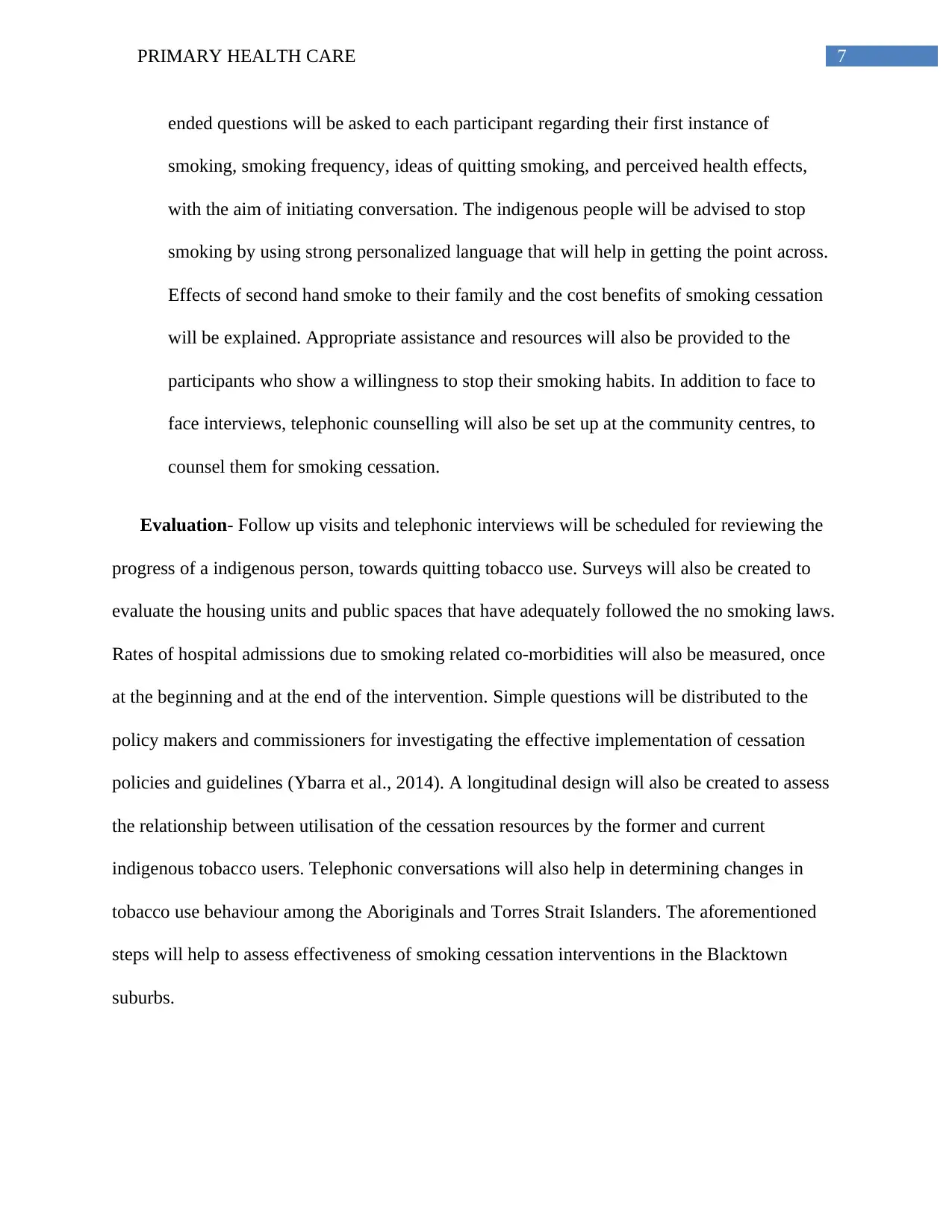
7PRIMARY HEALTH CARE
ended questions will be asked to each participant regarding their first instance of
smoking, smoking frequency, ideas of quitting smoking, and perceived health effects,
with the aim of initiating conversation. The indigenous people will be advised to stop
smoking by using strong personalized language that will help in getting the point across.
Effects of second hand smoke to their family and the cost benefits of smoking cessation
will be explained. Appropriate assistance and resources will also be provided to the
participants who show a willingness to stop their smoking habits. In addition to face to
face interviews, telephonic counselling will also be set up at the community centres, to
counsel them for smoking cessation.
Evaluation- Follow up visits and telephonic interviews will be scheduled for reviewing the
progress of a indigenous person, towards quitting tobacco use. Surveys will also be created to
evaluate the housing units and public spaces that have adequately followed the no smoking laws.
Rates of hospital admissions due to smoking related co-morbidities will also be measured, once
at the beginning and at the end of the intervention. Simple questions will be distributed to the
policy makers and commissioners for investigating the effective implementation of cessation
policies and guidelines (Ybarra et al., 2014). A longitudinal design will also be created to assess
the relationship between utilisation of the cessation resources by the former and current
indigenous tobacco users. Telephonic conversations will also help in determining changes in
tobacco use behaviour among the Aboriginals and Torres Strait Islanders. The aforementioned
steps will help to assess effectiveness of smoking cessation interventions in the Blacktown
suburbs.
ended questions will be asked to each participant regarding their first instance of
smoking, smoking frequency, ideas of quitting smoking, and perceived health effects,
with the aim of initiating conversation. The indigenous people will be advised to stop
smoking by using strong personalized language that will help in getting the point across.
Effects of second hand smoke to their family and the cost benefits of smoking cessation
will be explained. Appropriate assistance and resources will also be provided to the
participants who show a willingness to stop their smoking habits. In addition to face to
face interviews, telephonic counselling will also be set up at the community centres, to
counsel them for smoking cessation.
Evaluation- Follow up visits and telephonic interviews will be scheduled for reviewing the
progress of a indigenous person, towards quitting tobacco use. Surveys will also be created to
evaluate the housing units and public spaces that have adequately followed the no smoking laws.
Rates of hospital admissions due to smoking related co-morbidities will also be measured, once
at the beginning and at the end of the intervention. Simple questions will be distributed to the
policy makers and commissioners for investigating the effective implementation of cessation
policies and guidelines (Ybarra et al., 2014). A longitudinal design will also be created to assess
the relationship between utilisation of the cessation resources by the former and current
indigenous tobacco users. Telephonic conversations will also help in determining changes in
tobacco use behaviour among the Aboriginals and Torres Strait Islanders. The aforementioned
steps will help to assess effectiveness of smoking cessation interventions in the Blacktown
suburbs.

8PRIMARY HEALTH CARE
References
2016 Census QuickStats: Blacktown (C). (2018). Retrieved from
http://www.censusdata.abs.gov.au/census_services/getproduct/census/2016/quickstat/
LGA10750
American Diabetes Association. (2015). 4. Foundations of care: education, nutrition, physical
activity, smoking cessation, psychosocial care, and immunization. Diabetes
care, 38(Supplement 1), S20-S30.
Baum, F. E., Laris, P., Fisher, M., Newman, L., & MacDougall, C. (2013). “Never mind the
logic, give me the numbers”: Former Australian health ministers' perspectives on the
social determinants of health. Social Science & Medicine, 87, 138-146.
Brown, J., Kotz, D., Michie, S., Stapleton, J., Walmsley, M., & West, R. (2014). How effective
and cost-effective was the national mass media smoking cessation campaign
‘Stoptober’?. Drug & Alcohol Dependence, 135, 52-58.
Brown, T. J., Todd, A., O'Malley, C., Moore, H. J., Husband, A. K., Bambra, C., ... & Nield, L.
(2016). Community pharmacy-delivered interventions for public health priorities: a
systematic review of interventions for alcohol reduction, smoking cessation and weight
management, including meta-analysis for smoking cessation. BMJ open, 6(2), e009828.
Carson, K. V., Brinn, M. P., Labiszewski, N. A., Esterman, A. J., Chang, A. B., & Smith, B. J.
(2017). Community interventions for preventing smoking in young people. Health.
Rtrieved from- http://publichealthwell.ie/node/115315?
References
2016 Census QuickStats: Blacktown (C). (2018). Retrieved from
http://www.censusdata.abs.gov.au/census_services/getproduct/census/2016/quickstat/
LGA10750
American Diabetes Association. (2015). 4. Foundations of care: education, nutrition, physical
activity, smoking cessation, psychosocial care, and immunization. Diabetes
care, 38(Supplement 1), S20-S30.
Baum, F. E., Laris, P., Fisher, M., Newman, L., & MacDougall, C. (2013). “Never mind the
logic, give me the numbers”: Former Australian health ministers' perspectives on the
social determinants of health. Social Science & Medicine, 87, 138-146.
Brown, J., Kotz, D., Michie, S., Stapleton, J., Walmsley, M., & West, R. (2014). How effective
and cost-effective was the national mass media smoking cessation campaign
‘Stoptober’?. Drug & Alcohol Dependence, 135, 52-58.
Brown, T. J., Todd, A., O'Malley, C., Moore, H. J., Husband, A. K., Bambra, C., ... & Nield, L.
(2016). Community pharmacy-delivered interventions for public health priorities: a
systematic review of interventions for alcohol reduction, smoking cessation and weight
management, including meta-analysis for smoking cessation. BMJ open, 6(2), e009828.
Carson, K. V., Brinn, M. P., Labiszewski, N. A., Esterman, A. J., Chang, A. B., & Smith, B. J.
(2017). Community interventions for preventing smoking in young people. Health.
Rtrieved from- http://publichealthwell.ie/node/115315?
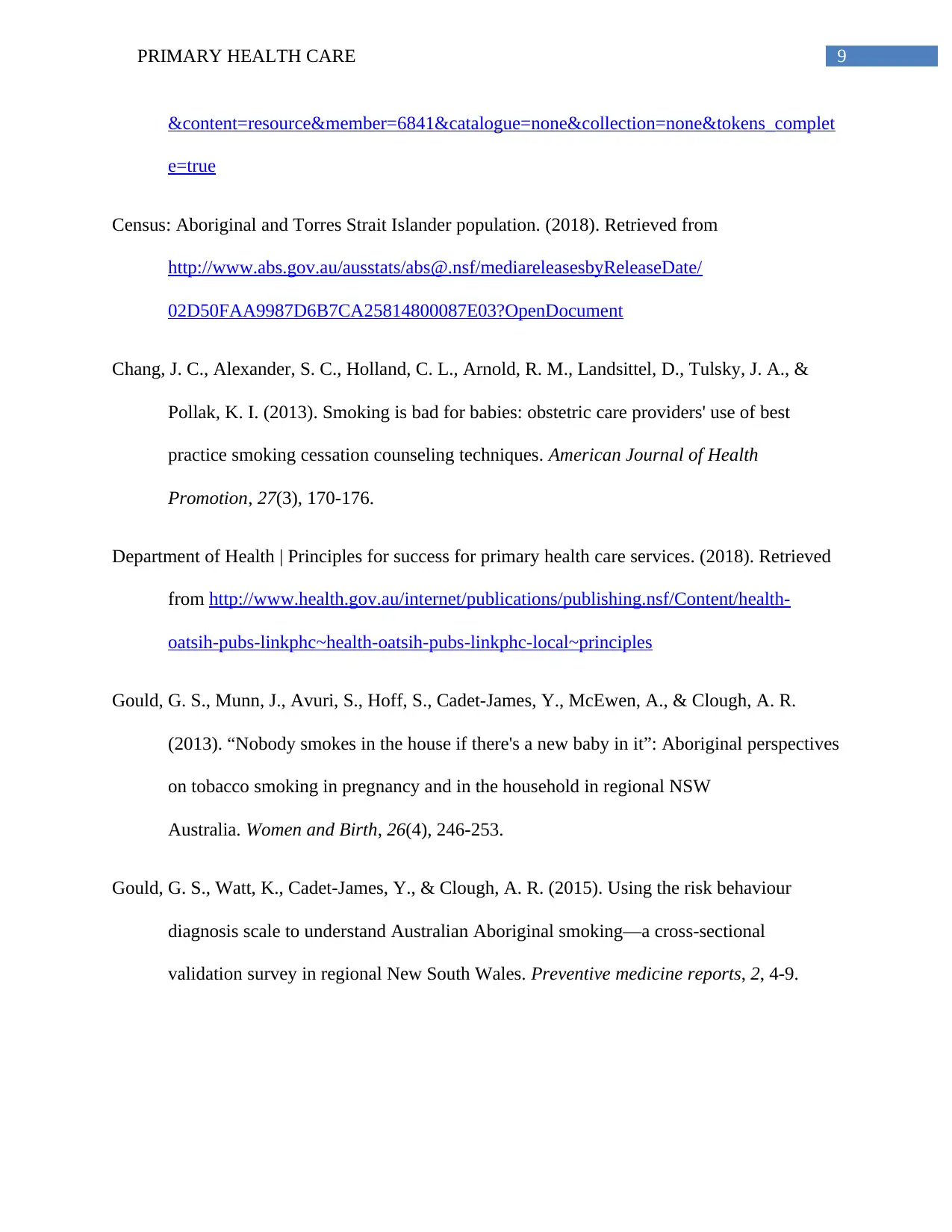
9PRIMARY HEALTH CARE
&content=resource&member=6841&catalogue=none&collection=none&tokens_complet
e=true
Census: Aboriginal and Torres Strait Islander population. (2018). Retrieved from
http://www.abs.gov.au/ausstats/abs@.nsf/mediareleasesbyReleaseDate/
02D50FAA9987D6B7CA25814800087E03?OpenDocument
Chang, J. C., Alexander, S. C., Holland, C. L., Arnold, R. M., Landsittel, D., Tulsky, J. A., &
Pollak, K. I. (2013). Smoking is bad for babies: obstetric care providers' use of best
practice smoking cessation counseling techniques. American Journal of Health
Promotion, 27(3), 170-176.
Department of Health | Principles for success for primary health care services. (2018). Retrieved
from http://www.health.gov.au/internet/publications/publishing.nsf/Content/health-
oatsih-pubs-linkphc~health-oatsih-pubs-linkphc-local~principles
Gould, G. S., Munn, J., Avuri, S., Hoff, S., Cadet-James, Y., McEwen, A., & Clough, A. R.
(2013). “Nobody smokes in the house if there's a new baby in it”: Aboriginal perspectives
on tobacco smoking in pregnancy and in the household in regional NSW
Australia. Women and Birth, 26(4), 246-253.
Gould, G. S., Watt, K., Cadet-James, Y., & Clough, A. R. (2015). Using the risk behaviour
diagnosis scale to understand Australian Aboriginal smoking—a cross-sectional
validation survey in regional New South Wales. Preventive medicine reports, 2, 4-9.
&content=resource&member=6841&catalogue=none&collection=none&tokens_complet
e=true
Census: Aboriginal and Torres Strait Islander population. (2018). Retrieved from
http://www.abs.gov.au/ausstats/abs@.nsf/mediareleasesbyReleaseDate/
02D50FAA9987D6B7CA25814800087E03?OpenDocument
Chang, J. C., Alexander, S. C., Holland, C. L., Arnold, R. M., Landsittel, D., Tulsky, J. A., &
Pollak, K. I. (2013). Smoking is bad for babies: obstetric care providers' use of best
practice smoking cessation counseling techniques. American Journal of Health
Promotion, 27(3), 170-176.
Department of Health | Principles for success for primary health care services. (2018). Retrieved
from http://www.health.gov.au/internet/publications/publishing.nsf/Content/health-
oatsih-pubs-linkphc~health-oatsih-pubs-linkphc-local~principles
Gould, G. S., Munn, J., Avuri, S., Hoff, S., Cadet-James, Y., McEwen, A., & Clough, A. R.
(2013). “Nobody smokes in the house if there's a new baby in it”: Aboriginal perspectives
on tobacco smoking in pregnancy and in the household in regional NSW
Australia. Women and Birth, 26(4), 246-253.
Gould, G. S., Watt, K., Cadet-James, Y., & Clough, A. R. (2015). Using the risk behaviour
diagnosis scale to understand Australian Aboriginal smoking—a cross-sectional
validation survey in regional New South Wales. Preventive medicine reports, 2, 4-9.
Secure Best Marks with AI Grader
Need help grading? Try our AI Grader for instant feedback on your assignments.
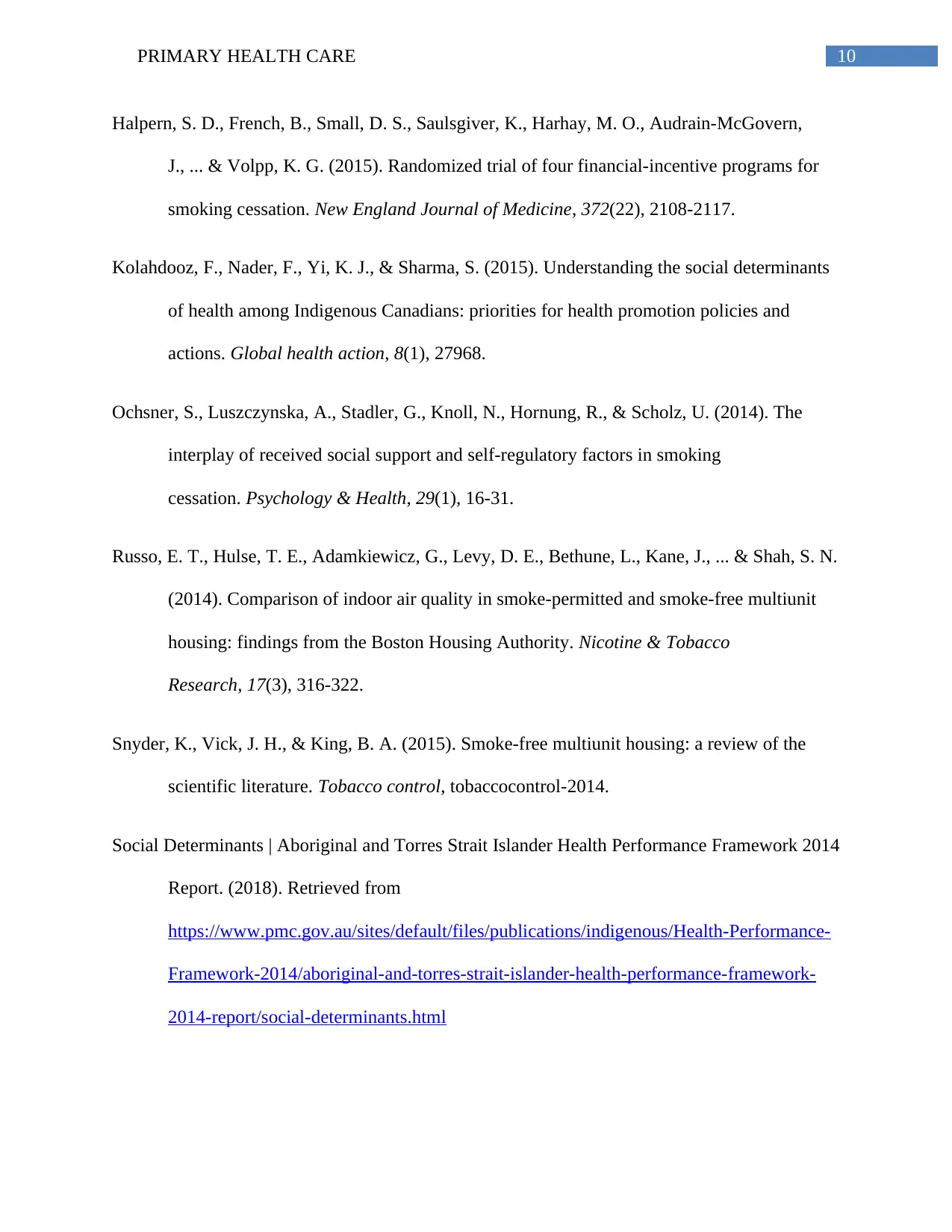
10PRIMARY HEALTH CARE
Halpern, S. D., French, B., Small, D. S., Saulsgiver, K., Harhay, M. O., Audrain-McGovern,
J., ... & Volpp, K. G. (2015). Randomized trial of four financial-incentive programs for
smoking cessation. New England Journal of Medicine, 372(22), 2108-2117.
Kolahdooz, F., Nader, F., Yi, K. J., & Sharma, S. (2015). Understanding the social determinants
of health among Indigenous Canadians: priorities for health promotion policies and
actions. Global health action, 8(1), 27968.
Ochsner, S., Luszczynska, A., Stadler, G., Knoll, N., Hornung, R., & Scholz, U. (2014). The
interplay of received social support and self-regulatory factors in smoking
cessation. Psychology & Health, 29(1), 16-31.
Russo, E. T., Hulse, T. E., Adamkiewicz, G., Levy, D. E., Bethune, L., Kane, J., ... & Shah, S. N.
(2014). Comparison of indoor air quality in smoke-permitted and smoke-free multiunit
housing: findings from the Boston Housing Authority. Nicotine & Tobacco
Research, 17(3), 316-322.
Snyder, K., Vick, J. H., & King, B. A. (2015). Smoke-free multiunit housing: a review of the
scientific literature. Tobacco control, tobaccocontrol-2014.
Social Determinants | Aboriginal and Torres Strait Islander Health Performance Framework 2014
Report. (2018). Retrieved from
https://www.pmc.gov.au/sites/default/files/publications/indigenous/Health-Performance-
Framework-2014/aboriginal-and-torres-strait-islander-health-performance-framework-
2014-report/social-determinants.html
Halpern, S. D., French, B., Small, D. S., Saulsgiver, K., Harhay, M. O., Audrain-McGovern,
J., ... & Volpp, K. G. (2015). Randomized trial of four financial-incentive programs for
smoking cessation. New England Journal of Medicine, 372(22), 2108-2117.
Kolahdooz, F., Nader, F., Yi, K. J., & Sharma, S. (2015). Understanding the social determinants
of health among Indigenous Canadians: priorities for health promotion policies and
actions. Global health action, 8(1), 27968.
Ochsner, S., Luszczynska, A., Stadler, G., Knoll, N., Hornung, R., & Scholz, U. (2014). The
interplay of received social support and self-regulatory factors in smoking
cessation. Psychology & Health, 29(1), 16-31.
Russo, E. T., Hulse, T. E., Adamkiewicz, G., Levy, D. E., Bethune, L., Kane, J., ... & Shah, S. N.
(2014). Comparison of indoor air quality in smoke-permitted and smoke-free multiunit
housing: findings from the Boston Housing Authority. Nicotine & Tobacco
Research, 17(3), 316-322.
Snyder, K., Vick, J. H., & King, B. A. (2015). Smoke-free multiunit housing: a review of the
scientific literature. Tobacco control, tobaccocontrol-2014.
Social Determinants | Aboriginal and Torres Strait Islander Health Performance Framework 2014
Report. (2018). Retrieved from
https://www.pmc.gov.au/sites/default/files/publications/indigenous/Health-Performance-
Framework-2014/aboriginal-and-torres-strait-islander-health-performance-framework-
2014-report/social-determinants.html
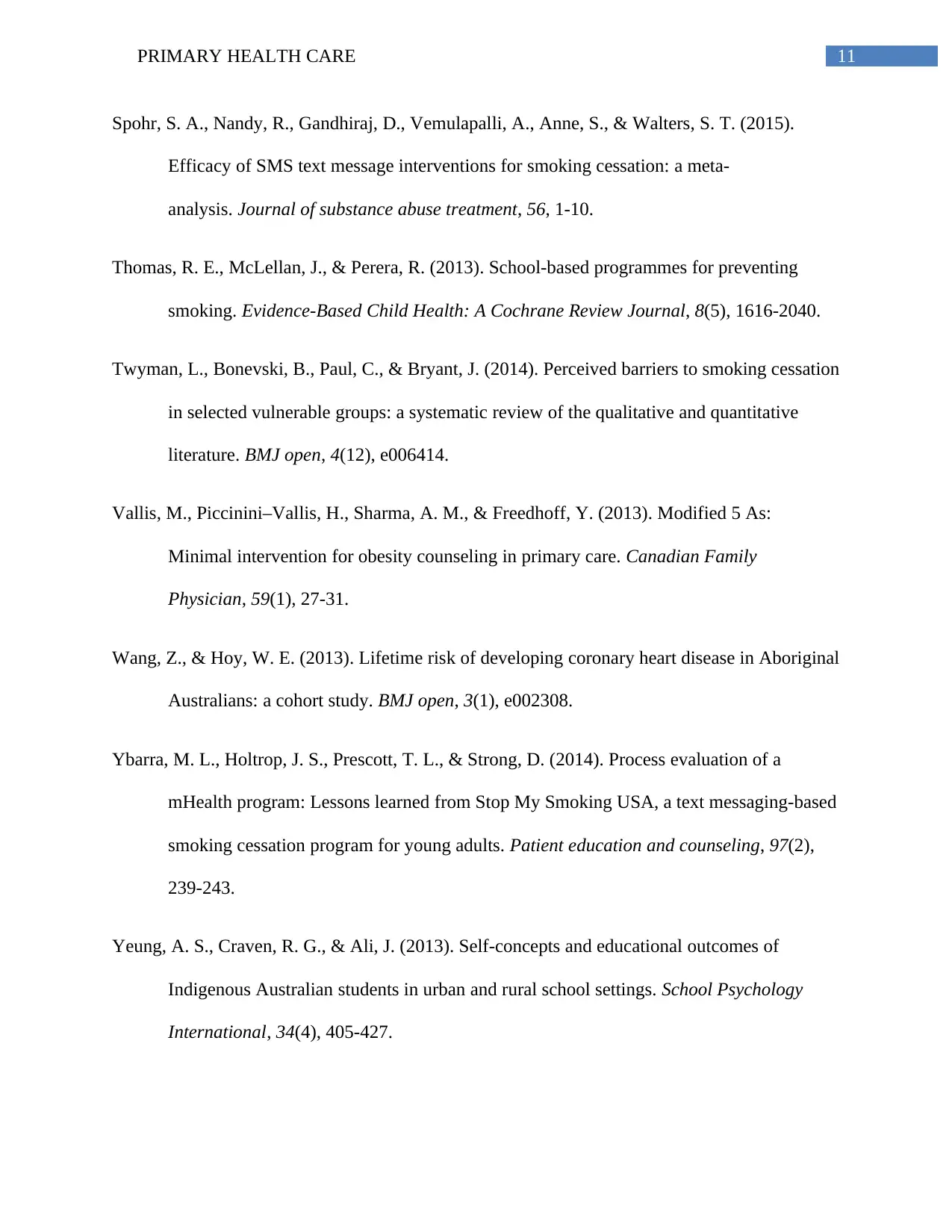
11PRIMARY HEALTH CARE
Spohr, S. A., Nandy, R., Gandhiraj, D., Vemulapalli, A., Anne, S., & Walters, S. T. (2015).
Efficacy of SMS text message interventions for smoking cessation: a meta-
analysis. Journal of substance abuse treatment, 56, 1-10.
Thomas, R. E., McLellan, J., & Perera, R. (2013). School‐based programmes for preventing
smoking. Evidence‐Based Child Health: A Cochrane Review Journal, 8(5), 1616-2040.
Twyman, L., Bonevski, B., Paul, C., & Bryant, J. (2014). Perceived barriers to smoking cessation
in selected vulnerable groups: a systematic review of the qualitative and quantitative
literature. BMJ open, 4(12), e006414.
Vallis, M., Piccinini–Vallis, H., Sharma, A. M., & Freedhoff, Y. (2013). Modified 5 As:
Minimal intervention for obesity counseling in primary care. Canadian Family
Physician, 59(1), 27-31.
Wang, Z., & Hoy, W. E. (2013). Lifetime risk of developing coronary heart disease in Aboriginal
Australians: a cohort study. BMJ open, 3(1), e002308.
Ybarra, M. L., Holtrop, J. S., Prescott, T. L., & Strong, D. (2014). Process evaluation of a
mHealth program: Lessons learned from Stop My Smoking USA, a text messaging-based
smoking cessation program for young adults. Patient education and counseling, 97(2),
239-243.
Yeung, A. S., Craven, R. G., & Ali, J. (2013). Self-concepts and educational outcomes of
Indigenous Australian students in urban and rural school settings. School Psychology
International, 34(4), 405-427.
Spohr, S. A., Nandy, R., Gandhiraj, D., Vemulapalli, A., Anne, S., & Walters, S. T. (2015).
Efficacy of SMS text message interventions for smoking cessation: a meta-
analysis. Journal of substance abuse treatment, 56, 1-10.
Thomas, R. E., McLellan, J., & Perera, R. (2013). School‐based programmes for preventing
smoking. Evidence‐Based Child Health: A Cochrane Review Journal, 8(5), 1616-2040.
Twyman, L., Bonevski, B., Paul, C., & Bryant, J. (2014). Perceived barriers to smoking cessation
in selected vulnerable groups: a systematic review of the qualitative and quantitative
literature. BMJ open, 4(12), e006414.
Vallis, M., Piccinini–Vallis, H., Sharma, A. M., & Freedhoff, Y. (2013). Modified 5 As:
Minimal intervention for obesity counseling in primary care. Canadian Family
Physician, 59(1), 27-31.
Wang, Z., & Hoy, W. E. (2013). Lifetime risk of developing coronary heart disease in Aboriginal
Australians: a cohort study. BMJ open, 3(1), e002308.
Ybarra, M. L., Holtrop, J. S., Prescott, T. L., & Strong, D. (2014). Process evaluation of a
mHealth program: Lessons learned from Stop My Smoking USA, a text messaging-based
smoking cessation program for young adults. Patient education and counseling, 97(2),
239-243.
Yeung, A. S., Craven, R. G., & Ali, J. (2013). Self-concepts and educational outcomes of
Indigenous Australian students in urban and rural school settings. School Psychology
International, 34(4), 405-427.

12PRIMARY HEALTH CARE
1 out of 13
Related Documents
Your All-in-One AI-Powered Toolkit for Academic Success.
+13062052269
info@desklib.com
Available 24*7 on WhatsApp / Email
![[object Object]](/_next/static/media/star-bottom.7253800d.svg)
Unlock your academic potential
© 2024 | Zucol Services PVT LTD | All rights reserved.





